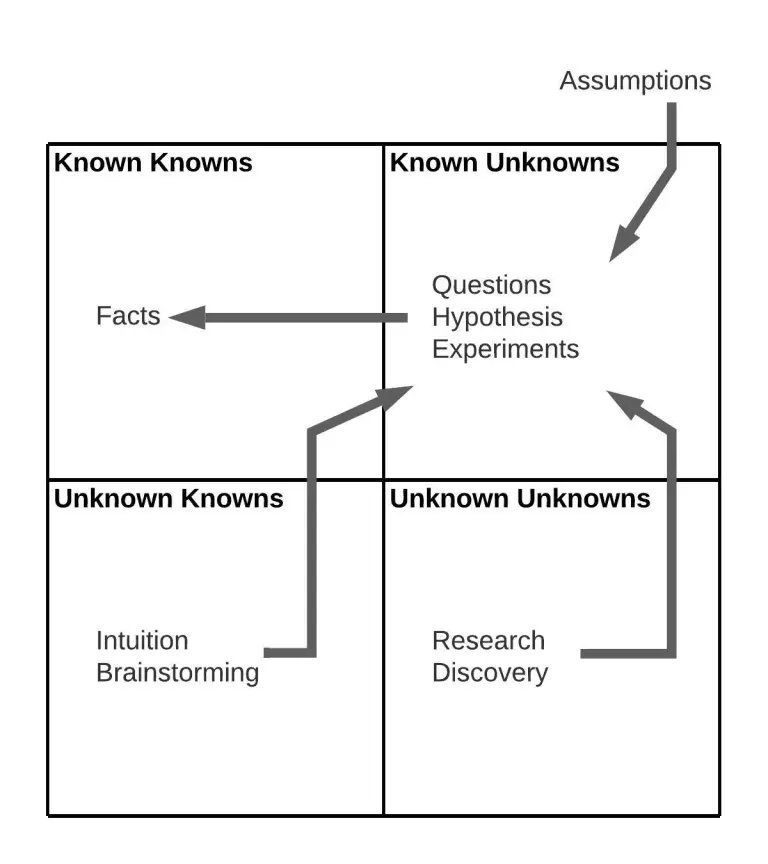
Introduction
In the complex and ever-evolving landscape of software development, operating in the gray, with it’s many uncertainties and ambiguities, is a reality that every software engineer faces. It is in this realm of uncertainty, the “Known and Unknown Framework” emerges as a guiding beacon, offering a structured approach to achieve continuous clarity of purpose. This framework empowers developers to identify the facts upon which their work can be firmly grounded, driving successful project outcomes.
The Known and Unknown Framework
At its core, the Known and Unknown Framework is a powerful tool that helps teams navigate the intricacies of the gray area by classifying information into distinct categories: known knowns, known unknowns, unknown knowns, and unknown unknowns. Let’s delve into each of these categories to understand their significance and how they contribute to achieving clarity of purpose.
Known Knowns: The Foundation of Solid Work
Known knowns represent the bedrock of factual information upon which sound decisions and work can be built. These are the certainties, the established truths that provide a reliable starting point for any software development endeavor. For example, well-documented specifications, existing codebase details, and proven algorithms fall into this category. Leveraging known knowns allows developers to undertake tasks with confidence, knowing they are on a solid foundation.
Known Unknowns: Igniting the Quest for Answers
Known unknowns are the questions that arise when faced with uncertainties. They represent gaps in understanding that, once addressed, can transform ambiguity into clarity. Embracing known unknowns is key to proactive problem-solving and ensuring that no stone is left unturned. These questions become a roadmap for further exploration, research, and discovery, enabling developers to convert uncertainties into known knowns.
Unknown Knowns: Harnessing Intuition
Sometimes, software development engineers possess a deep-rooted intuition that guides their decisions. These are the unknown knowns, the unspoken hunches that hold untapped potential. By acknowledging and converting these intuitive insights into known unknowns (questions), developers can subject them to scrutiny, leading to a deeper understanding of their value and relevance. This transformation ensures that intuition is not lost but rather refined and channeled toward concrete outcomes.
Unknown Unknowns: Embracing the Journey of Discovery
The realm of the unknown unknowns is where groundbreaking discoveries lie in wait. These are the surprises, the unforeseen challenges, and the unexplored opportunities that emerge as development progresses. Engaging in deliberate discovery sessions and research efforts helps developers unveil these hidden treasures, gradually transforming them into known unknowns and even known knowns. By proactively seeking the unknown, developers can expand their horizons and stay ahead in a rapidly evolving field.
Putting the Framework into Action
To harness the power of the Known and Unknown Framework, consider the following step-by-step process:
- Assumptions go into the Known Unknowns section – assumptions need to be turned into facts, so start there.
- Populate the Known Knowns and Known Unknowns Quadrants: Work with what you know and what you don’t know. This establishes a clear starting point for your project.
- Leverage Known Knowns for Solid Work: Utilize facts as building blocks for tasks that require certainty. These established facts become the pillars upon which your work stands.
- Iterative Clarity Building: Continuously identify new known knowns, turn known unknowns into known knowns, and prioritize tasks based on this evolving clarity. This iterative process ensures that your project remains aligned with emerging insights.
- Explore the Unknowns: Use brainstorming sessions to uncover unknown knowns, use discovery and research activities to unveil unknown unknowns. Turn these into known unknowns and continue the cycle.
Conclusion
In the dynamic world of software development, achieving continuous clarity of purpose amid uncertainties is a formidable challenge. The Known and Unknown Framework emerges as a beacon of guidance, offering a structured approach to categorize and leverage information effectively. By harnessing the power of known knowns, known unknowns, unknown knowns, and unknown unknowns, software development engineers can navigate the gray area with confidence, making informed decisions, and ultimately delivering successful outcomes. Remember, assumptions are the silent assassins that must be eliminated – this framework equips you to replace assumptions with solid facts, paving the way for excellence in your projects.
Text generated from my summarised list of bullet points by ChatGPT, August 12, 2023, OpenAI, https://chat.openai.com. Edited for style and content.
